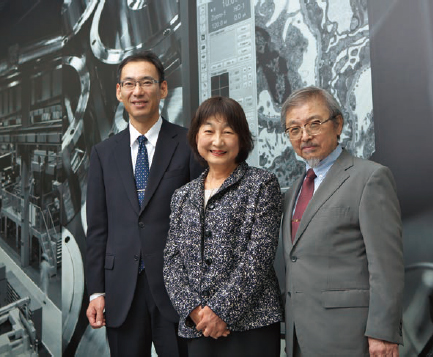5. A new beginning
Dr. Yamanaka has considered application of the LVSEM to tumor tissue diagnosis and cytologic examinations to detect cancer cells in pleural effusion and ascites fluids, with impressive results. To realize the full potential of LVSEM for renal biopsy diagnosis and nephropathologic research and its application to tissues other than renal and cases requiring fast, timely diagnosis, it will be necessary to ensure specimen quality and to develop and maintain the basic diagnostic criteria. It will also be necessary to ensure the capabilities of the image analyst to ensure the appropriate interpretation of the diagnostic pathology of specimens.
In the words of Dr. Okada, “With the LVSEM, calling up the image is easy. Seeing it there and thinking about it can be quite difficult. The first time I did it, Dr. Inaga was with me. She guided me one-on-one, pointing to objects on the screen and telling me which were cells, which were basement membranes, and so forth.”
“Without that kind of guidance, it is probably hard to understand what you’re looking at in the images when you see them for the first time. Things look somewhat different from what you’re used to seeing with light microscopes and immunofluorescent methods. You can make out the images of things, and yet you can’t tell what exactly they are. I think that in this sense, too, provision and publish of a database, such as 3D appearances of glomerular structure with epithelial cells, or that of IgA nephropathy for examples, and so forth, to develop the understanding, will be valuable.”
Dr. Yamanaka has long advocated for the construction of an expanding database containing a large number and variety of cases in order to develop and disseminate an understanding of the LVSEM histopathologic analysis method and its important advantages.
In his words, “The basic categorization of renal diseases has to some extent been determined, but the relatively rare cases in which (these diseases and) their lesions have been observed is still small, and with small numbers, there is always a possibility that their occurrence is unusual to those cases.”
“For the rare diseases such as Alport syndrome and thin basement membrane disease, the need is to gather many cases of each category and establish a database for making the correct diagnoses. This will require the broad distribution of LVSEM in use of the methodology.”
Dr. Inaga observes that reading LVSEM images is not in itself a difficult problem and that the essentials can be readily mastered in seminars with demonstration units. With her own experience in its development extending over 10 years, she notes that the task of expanding recognition and utilization as a superior methodology remains in the future.
In closing, she notes that “Renal pathology is the most difficult of pathologies. Even if an outsider of pathology like me will easily perform kidney diagnosis using this method, there will be no actual progress.
“Thanks to Dr. Yamanaka’s instruction and guidance in renal disease analysis and his introduction of this method in many venues, interest has grown among many. In a real sense, he has brought us to the starting line. In this spirit, it is my hope that an impressive volume and extensive range of data will be gathered, and that exact diagnostic criteria and methods will be identified and established, perhaps together with atlases or other forms of information, and widely disseminated.”
